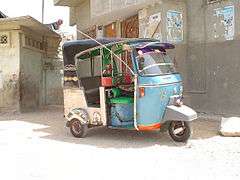Auto rickshaw
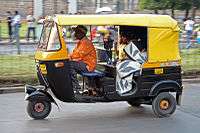
%2C_Jakarta.jpg)

.jpg)
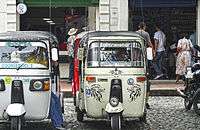
.jpg)
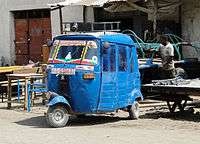
An auto rickshaw (in India), or rickshaw (in Pakistan) also known as a Bajay or Bajaj (in Jakarta, Indonesia) Bemo in Bali, Indonesia, three-wheeler or tuktuk (in Sri Lanka), samosa, tempo, tuk-tuk (in Thailand), trishaw, autorick, bajaji (in Madagascar and Tanzania), keke Napep or Maruwa (in Nigeria), rick, tricycle (in the Philippines), mototaxi, baby taxi, lapa or tukxi (Piaggio Ape Calessino) in popular parlance, is a motorized development of the traditional pulled rickshaw or cycle rickshaw.
Most have three wheels and do not tilt. An exception is in Cambodia, where two different types of vehicles are called tuk-tuks, one of which (also known as a remorque) has four wheels and is composed of a motorcycle (which leans) and trailer (which does not).
The auto rickshaw is a common form of urban transport, both as a vehicle for hire and for private use, in many countries around the world, especially those with tropical or subtropical climates, including many developing countries.
Overview

Origin
Japan has exported three-wheelers to Thailand since 1934. Moreover, The Ministry of Posts and Telecommunications of Japan donated about 20,000 used three-wheelers to Southeast Asia.[1][2][3][4] In Japan, three-wheelers went out of use in the latter half of the 1960s.[5]
In 1947, Corradino D'Ascanio, aircraft designer at Piaggio and inventor of the Vespa, came up with the idea of building a light three-wheeled commercial vehicle to power Italy's post-war economic reconstruction. The Piaggio Ape followed suit.
Auto rickshaws in Southeast Asia started from the knockdown production of the Daihatsu Midget which was introduced in 1957.
Design
There are many different auto rickshaw types, designs, and variations. The most common type is characterized by a sheet-metal body or open frame resting on three wheels, a canvas roof with drop-down side curtains, a small cabin at the front for the driver (sometimes known as an auto-wallah) with handlebar controls, and a cargo, passenger, or dual purpose space at the rear.
Engines
Daihatsu E-series engines are common in newer models.
Regional variations
Africa and the Middle East
Gaza
Together with the recent boom of recreational facilities in Gaza for the local residents, donkey carts have all but been displaced by tuk-tuks in 2010. Due to the ban by Egypt and Israel on the import of most motorised vehicles, the tuk-tuks have had to be smuggled in parts through the tunnel network connecting Gaza with Egypt.[6]
Madagascar
In Madagascar, man-powered rickshaws are a common form of transportation in a number of cities, especially Antsirabe. They are known as "posy" from pousse-pousse, meaning push-push. Cycle rickshaws took off since 2006 in a number of flat cities like Toamasina and replaced the major part of the posy, and are now threatened by the auto rickshaws, introduced in 2009. Provincial capitals like Toamasina, Mahajanga, Toliara, and Antsiranana are taking to them rapidly. They are known as "bajaji" in the north and "tuk-tuk" or "tik-tik" in the east, and are now licensed to operate as taxis. They are not yet allowed an operating licence in the congested, and more polluted national capital, Antananarivo.[7][8][9]
South Africa
Tuk-tuks, introduced in Durban[10] in the late 1980s enjoyed growing popularity in recent years, particularly in Gauteng.[11]
Tanzania
Rickshaws are locally known as "bajaji" and are a common mode of transportation in Dar es Salaam.[12]
Asia
Bangladesh
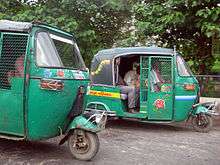
Auto rickshaws (locally called "baby taxis" and more recently "CNGs" due to their fuel source) are one of the more popular modes of transport in Bangladesh mainly due to their size and speed. They are best suited to narrow, crowded streets, and are thus the principal means of covering longer distances within urban areas.[13]
Two-stroke engines had been identified as one of the leading sources of air pollution in Dhaka. Thus, since January 2003, traditional auto rickshaws were banned from the capital; only the new natural gas-powered models (CNG) were permitted to operate within the city limits. All CNGs are painted green to signify that the vehicles are eco-friendly and that each one has a meter built-in.[14]
Cambodia
In Cambodia, the term tuk-tuk (Khmer: ទុកទុក) refers to a passenger-carrying remorque pulled by a motorcycle. It is a widely used form of transportation in the capital of Phnom Penh and for visitors touring the Angkor temples in Siem Reap. In Phnom Penh and other Cambodian cities tuk-tuk fares are negotiated with the driver, while at Angkor Wat they are typically rented on daily basis. Cambodian cities have a much lower volume of automobile traffic than Thai cities, and tuk-tuks are still the most common form of urban transport. There are more than 6,000 tuk-tuks in Phnom Penh, according to the Independent Democracy of Informal Economy Association (IDEA), a union that represents tuk-tuk drivers among other members.[15]
China

Various types of auto rickshaw are used around China, where they are called sān lún chē (三轮车) and sometimes sān bèng zǐ (三蹦子), meaning three wheeler or tricycle. They may be used to transport cargo or passengers in the more rural areas. However, in many urban areas the auto rickshaws for passengers are often operated illegally as they are considered unsafe and an eyesore.[16][17] They are permitted in some towns and cities, however. The Southeast Asian word tuk tuk is transliterated as dū dū chē (嘟嘟车, or beep beep car).[18]
India
Overview
Most cities offer auto rickshaw service, although hand-pulled rickshaws do exist in some areas, such as Kolkata.[19]
Auto rickshaws are used in cities and towns for short distances; they are less suited to long distances because they are slow and the carriages are open to air pollution.[20] Auto rickshaws (often called "autos") provide cheap and efficient transportation. Modern auto rickshaws run on compressed natural gas (CNG) and are environmentally friendly compared to full-sized cars.[nb 1]
It is also not uncommon in many parts of Indian metropolitan areas to see primary school children crammed into an auto rickshaw, transporting them between home and school, equivalent to the 'school run' performed by many parents in the West using their own cars.
To augment speedy movement of traffic, auto rickshaws are not allowed in the southern part of Mumbai.[21]
India is the destination to the annual Rickshaw Run.
Design and manufacture
There are two types of auto rickshaws in India. In older versions the engines were below the driver's seat, while in newer versions engines are in the rear. They normally run on petrol, CNG, or diesel. The seating capacity of a normal rickshaw is four, including the driver's seat. Six-seater rickshaws exist in different parts of the country, but the model was officially banned in the city of Pune on 10 January 2003 by the Regional Transport Authority (RTA).[22]
CNG autos in many cities (e.g. Delhi, Agra) are distinguishable from the earlier petrol-powered autos by a green and yellow livery, as opposed to the earlier black and yellow appearance. In other cities (such as Mumbai) the only distinguishing feature is the 'CNG' print found on the back or side of the auto. Some local governments are considering four-stroke engines instead of the current two-stroke versions.
Auto rickshaw manufacturers in India include Bajaj Auto, Kumar Motors, Kerala Automobiles Limited, Force Motors (previously Bajaj Tempo), Mahindra & Mahindra, Piaggio Ape, and TVS Motors.
-

Auto rickshaw in Goa
-
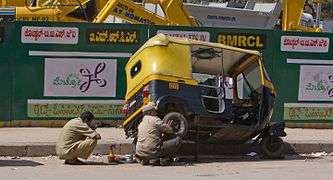
Auto rickshaw being repaired, Bangalore
-
CNG green auto rickshaw in Delhi
Legislation
Generally rickshaw fares are controlled by the government.[23]
Indonesia
In Indonesia, auto rickshaws are popular in Jakarta as Bajay, Java, Medan and Gorontalo as Bentor, and some parts of Sulawesi and other places in the country. In Jakarta, the auto rickshaws are called Bajay or Bajaj and they are the same to as the ones in India but are colored blue (for the ones who use Compressed natural gas) and orange (for the ones who use normal gasoline fuel). The blue ones are imported from India with the brand of Bajaj and TVS and the orange ones are the old design from 1990 and is not powered by gas like the blue ones, yet the government are increasing units of the blue Bajays and is step by step decreasing the orange bajays. The Bajaj is one of the most popular transportation in the city. Outside of Jakarta, the bentor-style auto rickshaw is more ubiquitous, with the passenger cabin mounted as a sidecar (like in Medan) or in-front (like the ones in some parts of Sulawesi) to a motorcycle.
-
Bentor in North Sumatra
-
Bentor in Tana Toraja, South Sulawesi
-
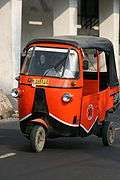
Gasoline fuelled Bajaj in Jakarta
-

CNG fuelled Bajaj in Jakarta.
Nepal
Auto rickshaws were a popular mode of transport in Nepal during the 1980s and 1990s, until the government banned the movement of 600 such vehicles in the early 2000s.[24] The earliest auto rickshaws running in Kathmandu were manufactured by Bajaj Auto.
Nepal has been a popular destination for the Rickshaw Run. The 2009 Fall Run took place in Goa, India and ended in Pokhara, Nepal.[25]
Pakistan
Auto rickshaws are a popular mode of transport in Pakistani towns[26] and are mainly used for travelling short distances within cities. One of the major brands of auto rickshaws is Vespa. The government is taking measures to convert all gasoline powered auto rickshaws to cleaner CNG rickshaws by 2015 in all the major cities of Pakistan by issuing easy loans through commercial banks. Environment Canada is implementing pilot projects in Lahore, Karachi, and Quetta with engine technology developed in Mississauga, Ontario, Canada that uses CNG instead of gasoline in the two-stroke engines, in an effort to combat environmental pollution and noise levels.
In many cities in Pakistan, there are also motorcycle rickshaws, usually called "chand gari" (moon car) or "chingchi" (after the Chinese company Jinan Qingqi Motorcycle Co. Ltd who first introduced these to the market).
Rickshaws are forbidden in the capital, Islamabad.
Auto rickshaws have had a history of displaying political statements. In February 2013, that legacy was modified to promote peace. According to Syed Ali Abbas Zaidi, head of the Pakistan Youth Alliance, "We need to take back this romanticized art form and use it for peace sloganeering and conflict resolution."[26]
There are many rickshaw manufacturers in Pakistan. Lahore is the hub of CNG auto rickshaw manufacturing. Manufacturers include: New Asia automobile Pvt, Ltd; AECO Export Company; STAHLCO Motors; Global Sources; Parhiyar Automobiles; Global Ledsys Technologies; Siwa Industries; Prime Punjab Automobiles; Murshid Farm Industries; Sazgar Automobiles; NTN Enterprises; and Imperial Engineering Company.
Philippines
Auto rickshaws are a popular form of public transportation in the Philippines, where they are referred to as "tricycles" (Filipino: traysikel; Cebuano: traysikol).[27] In the Philippines, the design and configuration of tricycles varies widely from place to place, but tends towards rough standardization within each municipality. The usual design is a passenger or cargo sidecar fitted to a motorbike, usually on the right of the motorbike. It is rare to find one with a left sidecar. Tricycles can carry five passengers or more in the sidecar, one or two pillion passengers behind the driver, and even a few on the roof of the sidecar. Tricycles are one of the main contributors to air pollution in the Philippines, since majority of them employ two-stroke engines. However, some local governments are working towards phasing out two-stroke tricycles for ones with cleaner four-stroke engines.
-
Motorized tricycle, Dumaguete City
-
7-passenger tricycle with large sidecar, Province of Aklan
-

Tricycle stand, Banaue Municipal Town
Sri Lanka

Auto rickshaws, commonly known as three-wheelers, can be found on all roads in Sri Lanka from the curvy roads in the hill country to the congested roads of Colombo transporting locals, foreigners, or freight about. Sri Lankan three-wheelers are of the style of the light Phnom Penh-type. Most of the three-wheelers in Sri Lanka are a slightly modified Indian Bajaj model, imported from India though there are few manufactured locally and increasingly imports from other countries in the region and other brands of three-wheelers such as Piaggio Ape. In January 2007 the Sri Lankan government imposed a ban on all 2-stroke three-wheelers, due to environmental concerns. Ones imported to the island now are four-stroke engines. Most three-wheelers are available as hired vehicles, with few being used to haul goods or as private company or advertising vehicles. Bajaj enjoys a virtual monopoly in the island, with its agent being David Pieries Motor Co, Ltd.[28] A few three-wheelers in Sri Lanka have distance meters. In the capital city it is becoming more and more common. The vast majority of fares are negotiated between the passenger and driver. In Sri Lanka more than 10,000 drivers are registered with TukTuk Sri Lanka which connects tuk drivers with passenger via a mobile application for taxi hailing.[29]
Thailand
The auto rickshaw, called tuk-tuk (Thai: ตุ๊ก ๆ) in Thailand, is a widely used form of urban transport in Bangkok and other Thai cities. The name is onomatopoeic, mimicking the sound of a small (often two-cycle) engine. An equivalent English term would be "putt-putt". It is particularly popular where traffic congestion is a major problem, such as in Bangkok and Nakhon Ratchasima. Drivers may also use their tuk-tuks to transport fresh produce or other goods around the city in absence of passengers.
Bangkok and other cities in Thailand have many tuk-tuks which are a more open variation on the Indian auto rickshaw. Bangkok alone is reported to have 9,000 tuk-tuks.[30]
-

Tuk-tuk in Bangkok
-

Police tuk-tuk, Chiang Mai
-
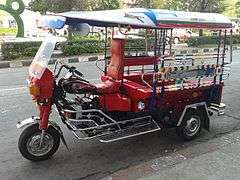
Udon-style tuk-tuk in Udon Thani
Europe
France
A number of tuk-tuks (250 in 2013 according to the Paris Prefecture) are used as an alternative tourist transport system in Paris, some of them being pedal-operated with electric motor assist. They are not yet fully licensed to operate and await customers on the streets. Vélotaxis were common during the Occupation years in Paris due to fuel restrictions.[31]
Italy

Auto rickshaws have been commonly used in Italy since the late 1940s, providing a low-cost means of transportation in the post-World-War-II years when the country was short of economic resources. The Piaggio Ape (Tukxi), designed by Vespa creator Corradino D'Ascanio and first manufactured in 1948 by the Italian company Piaggio, though primarily designed for carrying freight has also been widely used as an auto rickshaw. It is still extremely popular throughout the country, being particularly useful in the narrow streets found in the center of many little towns in central and southern Italy. Though it no longer has a key role in transportation, Piaggio Ape is still used as a minitaxi in some areas such as the islands of Ischia and Stromboli (on Stromboli no cars are allowed). It has recently been re-launched as a trendy-ecological means of transportation, or, relying on the role the Ape played in the history of Italian design, as a promotional tool. Since 2006 the Ape has been produced under licence in India.
United Kingdom
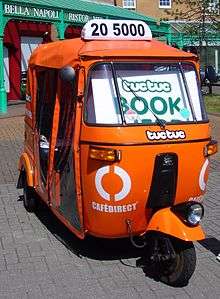
Auto rickshaws were introduced to the city of Brighton and Hove on 10 July 2006 by entrepreneur Dominic Ponniah's company Tuctuc Ltd. Ponniah had the idea after seeing the vehicles used in India and Sri Lanka. They were CNG-powered, using a four-speed (plus reverse) 175 cc engine. Under the terms of their license, the Bajas ran on a fixed single route, and stopped only at designated stops. They are of the same design as traditional auto rickshaws in other countries.
An investigation was launched into Tuctuc Ltd's operation of the service after complaints were raised, primarily by the city's taxi drivers, that routes, stopping points and timetables were not being adhered to.[32] In November 2006, the company was fined £16,500 — the maximum penalty possible — by the South East Traffic Commissioner. After amendments were made to the timetable to reduce delays and improve reliability, the Commissioner allowed the company to keep its operating license.[33] However, the company announced in January 2008 that it was ceasing operations, citing "archaic legislation" as the reason.[34]
In 2014, Tuk Tuk (UK) Ltd started to import vehicles made by Bajaj and produced in Mumbai. Tuk Tuk UK gain UK road approval for the vehicles and sell or rent them. On Wednesday 25 June 2016 two tuk tuks appeared on the talent show, Britain's Got Talent. On 19 January 2016 the operator of a tuk tuk, Deva Tuk Tuk gained approval to use the vehicle for private hire purposes from Chester Council.[35]
Central America
El Salvador
The mototaxi or moto is the El Salvadoran version of the auto rickshaw. These are most commonly made from the front end and engine of a motorcycle attached to a two-wheeled passenger area in back. Commercially produced models, such as the Indian Bajaj brand, are also employed.
Guatemala
In Guatemala the commercial vehicles are referred to as tuk-tuks. Tuk-tuks operate, both as taxis and private vehicles, in Guatemala City, around the island town of Flores, Peten, in the mountain city of Antigua Guatemala, and in many small towns in the mountains. In 2005 the tuk-tuks prevalent in the Lago de Atitlán towns of Panajachel and Santiago Atitlán all appeared to be from India (Bajaj Auto).
Honduras
Three-wheeled all-in-one tuk-tuks are used in the place of traditional taxis in most rural towns and villages.
Nicaragua
As of 2011, there were an estimated 5,000 mototaxis, popularly known as "caponeras".[36]
North America

United States
In the 1950s and 1960s, the US Postal Service used the WestCoaster Mailster, a close relative of the current Tuk-tuk. This link describes the experience of the USPS.
Fuel efficiency and pollution
.jpg)
In July 1998, the Supreme Court of India ordered the Government of Delhi to implement CNG or LPG (Autogas) fuel for all autos and for the entire bus fleet in and around the city. Delhi's air quality has improved with the switch to CNG. Initially, auto rickshaw drivers in Delhi had to wait in long queues for CNG refueling, but the situation improved following an increase in the number of CNG stations. Gradually, many state governments passed similar laws, thus shifting to CNG or LPG vehicles in most large cities to improve air quality and reduce pollution. Certain local governments are pushing for four-stroke engines instead of the current two-stroke ones. Typical mileage for an Indian-made auto rickshaw is around 35 kilometres per litre (99 mpg-imp; 82 mpg-US) of petrol. Pakistan has passed a similar law prohibiting auto rickshaws in certain areas. CNG auto rickshaws have started to appear in huge numbers in many Pakistani cities.
In January 2007 the Sri Lankan government also banned two-stroke trishaws to reduce air pollution. In the Philippines[37] there are projects to convert carburated two-stroke engines to direct-injected via Envirofit technology. Research has shown LPG or CNG gas direct-injection can be retrofitted to existing engines, in similar fashion to the Envirofit system.[38] In Vigan City majority of tricycles-for-hire as of 2008 are powered by motorcycles with four-stroke engines, as tricycles with two-stroke motorcycles are prevented from receiving operating permits. Direct injection is standard equipment on new machines in India.[39][40]
In March 2009 an international consortium coordinated by the International Centre for Hydrogen Energy Technologies initiated a two-year public-private partnership of local and international stakeholders aiming at operating a fleet of 15 hydrogen-fueled three-wheeled vehicles in New Delhi's Pragati Maidan complex.[41] As of January 2011, the project was upon completion.
In the meantime, in October 2011, the Department of Transportation for the U.S. approved the complete 2012 series of American made, all-electric tuk tuks by Electro Technologies. Chassis were still being shipped in from Thailand, but now with the inclusion of all electrical components as manufactured only in the U.S. with assembly completed in Chattanooga, Tennessee. The American made electric tuk tuks were unique in that they were charged through common 110v outlets providing a range of 97 to 161 kilometres (60 to 100 mi) per charge (depending upon model and conditions) with a recharge time between 4 and 6 hours. The Electro Technologies Tuk Tuks topped out at 64 kilometres per hour (40 mph) which perfectly addresses the needs of their design; niche urban mobile transportation.
The greatest obstacle to daily usage in niche urban mobile commercial transportation was overcome in 2013 by Electro Technologies, when they introduced their quick-release battery pack, allowing for restoration of 100% power availability in just a few minutes. This commercial upgrade allowed niche urban transportation businesses to operate 24/7 with no interruption to business.
See also
Notes
- ↑ Typical fuel economy for an Indian-made auto rickshaw is around 35 kilometres per litre (99 mpg-imp; 82 mpg-US) of petrol.
References
- ↑ ミゼット物語 木村信之 著 高原書店(Nobuyuki Kimura "Story of Midget", Published on November 10, 1998)
- ↑ Daihatsu Motor Co., Ltd. public relations section
- ↑ NPOみらいネットワーク寄附講座、ホテル観光学科の学生に日タイ関係をピーアール 日本での就職機会に関心. Bangkok Shuho (in Japanese). 2007-11-19. Archived from the original on 2009-04-30.
- ↑ /index.php?option=com_content&view=article&id=321:2009-11-30-05-34-59&catid=54:2009-09-09-07-52-31&Itemid=232 Royal Thai Embassy Tokyo, Japan 日本生まれのタイのトゥクトゥク(Tuk-Tuk of Thailand was born in Japan.)
- ↑ The Japanese Government abolished the three-wheeler license in 1965.
- ↑ "Tuk Tuks replace mules on Gaza streets,". Maan News Agency. September 12, 2010. Retrieved 2011-03-22.
- ↑ Jay Heale; Zawiah Abdul Latif (2008). Madagascar, Volume 15 of Cultures of the World Cultures of the World - Group 15 (2 ed.). Marshall Cavendish. pp. 75–76. ISBN 0761430369.
- ↑ Madagascar Travel Guide (7 ed.). Lonely Planet. 2012. ISBN 1743213018. Retrieved 2013-04-13.
- ↑ "'Bajaj' à Mahajanga : Entre 70 et 100 clients par jour". Midi Madagasikara (in French). 2014-05-30.
- ↑ "Durban offers beaches and culteral diversity". Zululand Tourism. Retrieved 22 September 2015.
Tuk Tuks: Mororised, covered tricycles which carry up to six passangers. Ideal for short 'hops' between the beachfront and city centre.
- ↑ Steyn, Lisa (18 January 2013). "Cheap-cheap tuk-tuk taxis take over Jozi". Retrieved 22 September 2015.
Tuk-tuks, also known as auto rickshaws, are becoming an increasingly common sight on South Africa's roads because people are trying to travel short distances at lower costs than driving and at less risk than walking.
- ↑ Kalagho, Kenan (13 February 2012). "Tanzania: Bajaji, Dar es Salaam's Indispensable Taxi". AllAfrica. Retrieved 22 September 2015. (subscription required (help)).
Until the year 2010 Dar es Salaam had no room for the Indian Bajaji and or a tricycle to be used as a means of transporting passengers. Today it is a common feature around Dar es Salaam.
- ↑ Lane, Jo. "Asia's love affair with the rickshaw". asiancorrespondent.com. asiancorrespondent.com. Retrieved 2015-07-30.
- ↑ "Police purge for Dhaka rickshaws". BBC. December 20, 2002. Retrieved 2011-03-22.
- ↑ WILKINS, Emily (February 19, 2014). "New Futuristic Tuk-Tuks Arrive on the Streets of Phnom Penh". The Cambodia Daily. Retrieved January 30, 2015.
- ↑ "明珠路上规模浩大的等客车队 危险逆行载客". 珠江晚报. 3 November 2009. Archived from the original on 2015-04-04.
- ↑ "[天津]面对"三蹦子" 请您大声说"不"". auto sohu.
- ↑ "東南亞的三輪車". Global Voices. 25 March 2012.
- ↑ Pippa de Bruyn; Keith Bain; David Allardice; Shonar Joshi. Frommer's India (Fourth ed.). 2010: John Wiley and Sons. pp. 15, 57, 156. ISBN 0470645806.
- ↑ Pippa de Bruyn; Keith Bain; David Allardice; Shonar Joshi. Frommer's India (Fourth ed.). 2010: John Wiley and Sons. pp. 57–58, 110. ISBN 0470645806.
- ↑ Pippa de Bruyn; Keith Bain; David Allardice; Shonar Joshi (2010). Frommer's India (Fourth ed.). John Wiley and Sons. p. 110. ISBN 0470645806.
- ↑ "Six seater rickshaws banned in city". Times of India. 25 September 2003. Retrieved 2014-01-11.
- ↑ "Maharashtra Govt refuses to increase autorickshaw, taxi fares". newKerala.com. UNI. Archived from the original on 2013-05-18.
- ↑ "Nepal Government decides to ban 3 wheeler auto rickshaws from Nepal's road". BBC. July 28, 1999. Retrieved 2011-12-06.
- ↑ "Rickshaw Run on 3 Wheelers from Goa, India to Pokhara, Nepal". The National. August 29, 2009. Retrieved 2011-12-06.
- 1 2 Sebastian Abbot, Associated Press (February 8, 2013). "Eye-Catching Rickshaws Promote Peace in Pakistan". ABC News. Retrieved 2013-04-13.
- ↑ "Motorcycles and tricycles". Utrecht Faculty of Education. Archived from the original on 7 March 2009. Retrieved 2009-03-14.
- ↑ "Bajaj ready with 4-stroke autos for SL". Indiacar.net. Retrieved 2010-04-03.
- ↑ "Smart new Tuk Tuk App will take you places". Daily FT. Colombo. 31 December 2015.
- ↑ "Thailand government says Bangkok has too many 'tuk-tuks'". Asian Correspondent. 2016-04-15. Retrieved 2016-04-15.
- ↑ "A Paris, les tuk-tuks fleurissent... tout comme les PV". La Dépêche (in French). Toulouse. AFP. 2013-08-20.
- ↑ "Public inquiry into tuk-tuk firm". BBC News. 2006-09-13. Retrieved 2009-03-14.
- ↑ "Tuctuc Ltd fined for breach of Public Service Vehicle License". BBC News. 2006-11-03. Retrieved 2010-04-03.
- ↑ "Tuk-tuks to be taken off the road". BBC News Sussex. 19 January 2008. Retrieved 2009-05-03.
- ↑ Barrett, Frances (2016-01-19). "Chester Tuk Tuk taxi gets the go-ahead from council". chesterchronicle. Retrieved 2016-06-01.
- ↑ The Invasion of the Moto-Taxis
- ↑ "Envirofit's Tricycle Retrofit Program Funded". Colorado State University. May 19, 2006. Retrieved 2011-03-22.
- ↑ "Microsoft Word - SETC_LPG2T.doc" (PDF). Retrieved 2010-04-03.
- ↑ "Bajaj rolls out low-emission fuel-efficient autorickshaw". Business Line. The Hindu. 2007-12-09. Retrieved 2010-04-03.
- ↑ "Bajaj Begins Production of 2-Stroke Direct-Injection Auto Rickshaw". Green Car Congress. 2007-05-18. Retrieved 2010-04-03.
- ↑ "A fleet of hydrogen rickshaws to circulate in New Delhi by 2010". International Centre for Hydrogen Energy Technologies. Archived from the original on 2011-07-28. Retrieved 2011-03-22.
External links
| Wikimedia Commons has media related to Auto-rickshaws. |
- Article: Hybrid tuk-tuks are coming
- The India 1000 – an article in Wired about auto rickshaw racing
